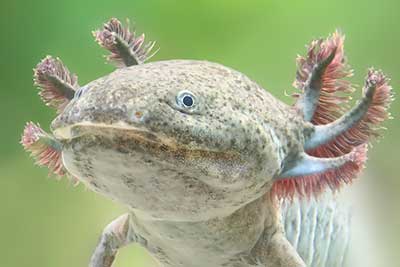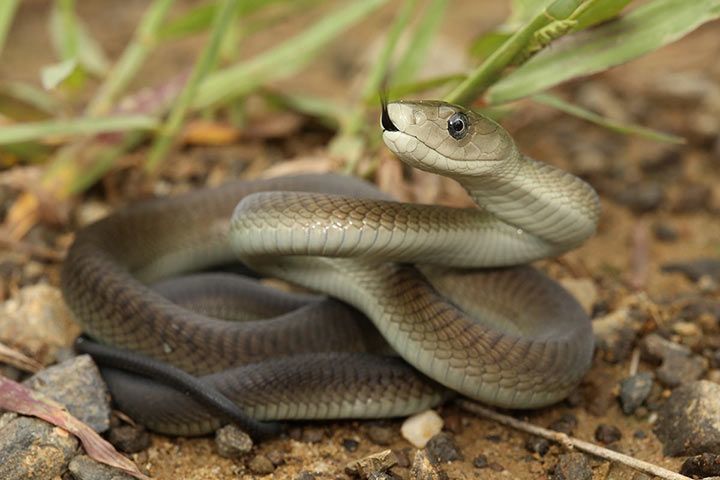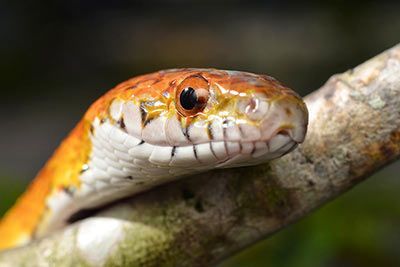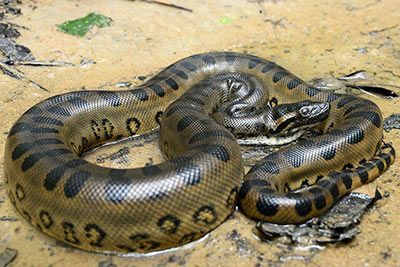Red-Eyed Tree Frog
Poison Dart Frog Facts
| Size | 2-3 inches (6-8 cm) (body length) |
| Speed | Unknown |
| Weight | 0.2-0.5 ounces (6-15 grams) |
| Lifespan | 5 years |
| Food | Crickets, moths, grasshoppers, flies, mosquitoes |
| Predators | Primates, snakes, bats, dragonflies |
| Distribution | Central America, South America |
| Habitat | Ponds, wet areas, tropical rainforests |
| Class | Amphibians |
| Order | Anura |
| Family | Hylidae |
| Scientific name | Agalychnis callidryas |
| Characteristics | Colorful tropical frog with striking red eyes |
Main Characteristics
The red-eyed tree frog is a bright, colorful frog. Its most striking feature is its large, red eyes with vertical, black slits. It lives in tropical rainforests in Central and South America. Although it has numerous enemies, it also has clever tricks to survive. The red-eyed tree frog is a symbol of the protection and preservation of the rainforest.
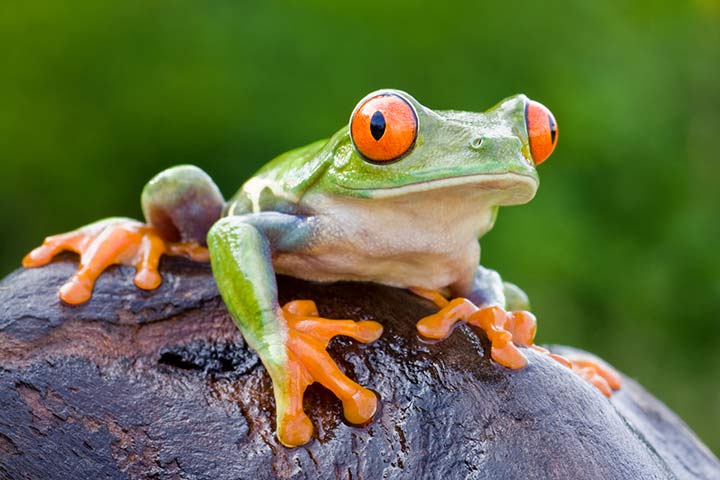
Distribution and Habitat
Red-eyed tree frogs live in Central and South America: Belize, Colombia, Costa Rica, Guatemala, Honduras, Mexico, Nicaragua, and Panama. Their habitat is tropical rainforests with small ponds and lakes. They need at least 80% humidity to survive.
Life Style
Red-eyed tree frogs live a solitary life. They're nocturnal. They rest during the day and become active at night, either hunting small insects or searching for a partner. They spend most of their time climbing in plants and trees, but they are also skilled at jumping and swimming. During mating season, males try to scare away their rivals by quivering and shaking plants.
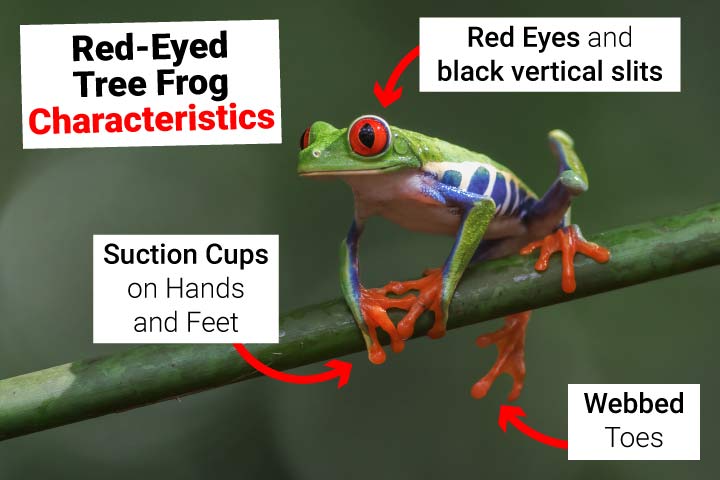
Anatomy and Appearance
Size and Weight
Red-eyed tree frogs are small frogs. Their body length is 2-3 inches (60-80 mm). The females are larger than the males.
Color
Red-eyed tree frogs have vibrant colors, with a light green upper side, orange hands and feet, and a white belly. Their sides, arms, and legs are a mix of blue and yellow, which are known as "warning colors".
Eyes
The red-eyed tree frog has bright red eyes with a vertical, black slit. They don't have an eyelid to close their eyes. Instead, they have a so-called nictitating membrane, which they draw across the eye like protective glasses.
Suction Cups
Red-eyed tree frogs have suction cups on their hands and feet. With their help they cling to the underside of leaves.
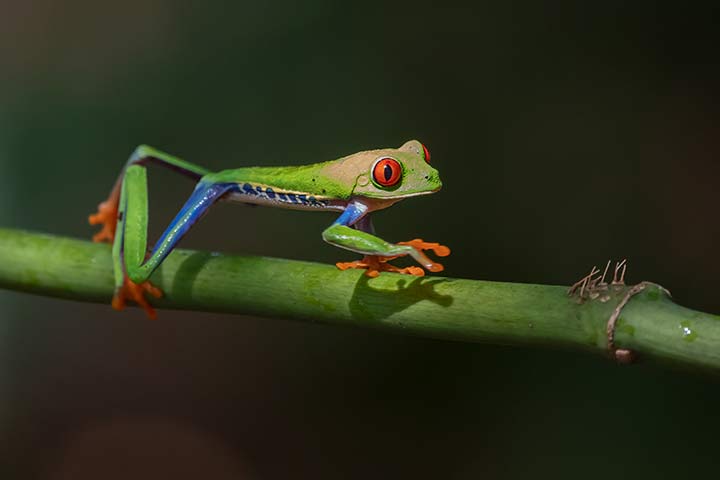
Diet
Red-eyed tree frogs are carnivores, more specifically insectivores. They feed on insects such as crickets, butterflies, grasshoppers, flies, mosquitoes, and ants. The tadpoles feed on plankton, algae and bacteria.
Behavior
Sounds
Red-eyed tree frogs have interesting sounds. When they are looking for a partner, they make “chack” or “chack-chack”. When they want to scare off a rival, their call sounds like laughter or warbling.
Quivering
Male red-eyed tree frogs protect their territory during mating season to increase their chances of attracting a mate. They sit on a branch and shake it by quivering with their whole body. Even though the frog is so small, the vibration travels around 60 inches (150 cm) through the branches. Their rivals feel the vibrations and, with a bit of luck, they're intimidated and leave the place.
Senses and Abilities
Sense of Sight
Red-eyed tree frogs have a very good sense of sight, particularly during the night.
Camouflage
Red-eyed tree frogs sleep during the day. To avoid being discovered by predators, they camouflage themselves. They pull their arms and legs close to their bodies and close their eyes using their nictitating membranes. Their vibrant colors are no longer visible, making them well camouflaged. They're just as green as the leaves they sleep on.
Poison
Red-eyed tree frogs have moist, poisonous skin. The poison kills bacteria and viruses and protects them from skin diseases. However, unlike poison dart frogs, their poison is harmless and not dangerous to humans. Anyone who accidentally touches a red-eyed tree frog should still wash their hands to be on the safe side.
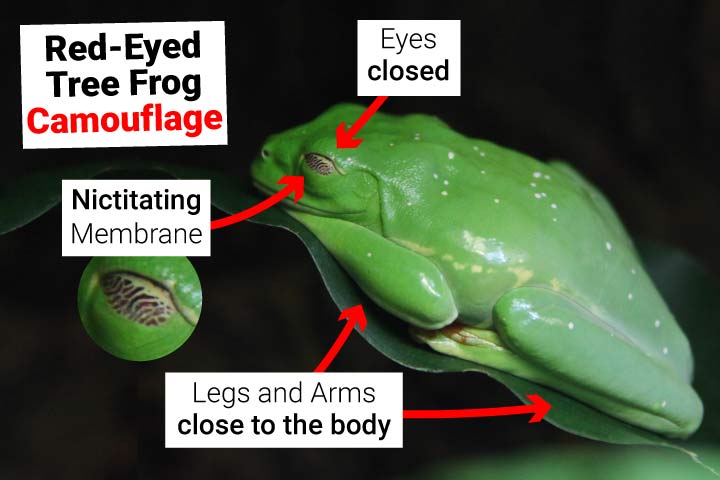
Defense
Warning Colors
Their vibrant hues are known as warning colors, serving as a signal to other creatures: "I'm toxic, stay away!" Although the frog isn't as venomous as its counterparts, the strategy appears to be effective.
Vibration Detecting
The larvae of red-eyed tree frogs are a tasty snack for many predators. Luckily, they have a clever trick to survive. As soon as an enemy comes near, the larvae sense the vibrations, quickly hatch from their eggs and plunge into the water. This strategy allows a significant number of the brood to survive. The larvae possess remarkable intelligence, enabling them to accurately differentiate between the vibrations caused by approaching enemies and those caused by raindrops or gusts of wind.
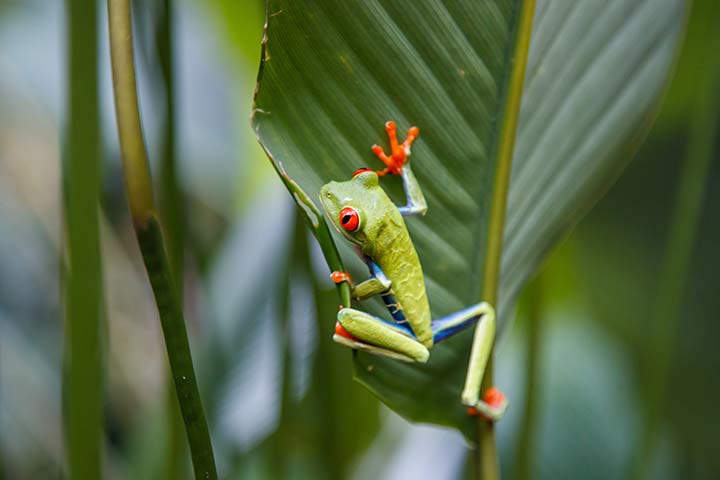
Life Expectancy
In the wild, red-eyed tree frogs live up to five years.
Enemies and Threats
The red-eyed tree frog has many enemies: primates, snakes, bats, fish, dragonflies and beetles. Other threats include loss of habitat, pollution and rising temperatures due to climate change. Luckily, it is not considered an endangered species at the moment.
Importance for the Ecosystem
Red-eyed tree frogs are very important to the ecosystem. As tadpoles, they feed on algae and help prevent overgrowth. As frogs, they help keep the number of insects in balance.
Red-eyed Tree Frogs as Pets
The red-eyed tree frog is a fascinating and exceptionally beautiful amphibian. It's no wonder that many people ask: Can I keep it as a pet? The answer is: Yes, that is actually possible. But it's not easy. The animal needs a terrarium that is appropriately set up for its needs. The humidity has to be at least 80% and the temperature must be permanently at 25-30 degrees Celsius. The animals also need a small pool with fresh water and tropical plants. A special lamp with a timer provides 11-12 hours of “daylight”. Mastering the requirements is possible, but it demands careful attention and responsibility to ensure the animal's well-being.
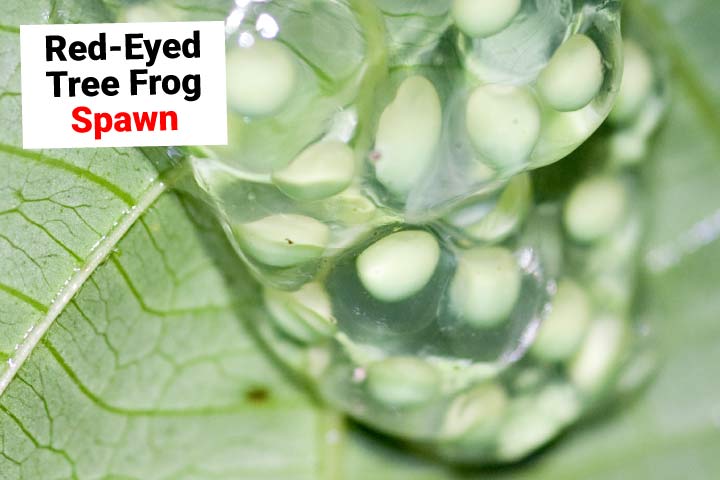
Reproduction
Mating Season
Red-eyed tree frogs reproduce in the rainy season from May to November.
Eggs
The female climbs up a plant growing on the shore directly above the water, with the male on her back. She lays 40 eggs at a time - up to five times in total. The eggs are surrounded by a transparent, sticky, slimy fluid, forming a kind of "clump" that sticks to the leaf. The male fertilizes the eggs immediately after laying.
Development
The tadpoles hatch about 6-8 days after the eggs are laid. They wobble back and forth in their transparent egg, break through the soft shell and plunge into the water below them. Larvae that don't drop into the water must rely on rain to wash them into the water within 20 hours. At this point they don't have arms or legs to move around.
Metamorphosis
The tadpoles spend 80 days in the water. During this time they develop. Their gills become lungs, their paddle tails recede, and they grow arms and legs. This process is called metamorphosis (Greek word for transformation). After 80 days, they complete their transformation into frogs and gain the ability to move on land.
The Red-Eyed Tree Frog Is Related To:
- Leaf Frog
- Tree Frog
Animals in the Same Biome:
- Ant
- Tree Snake
- Bat
- Fly
- Grasshopper
- Dragonfly
- Moth
- Water Beetle
Related Articles:







